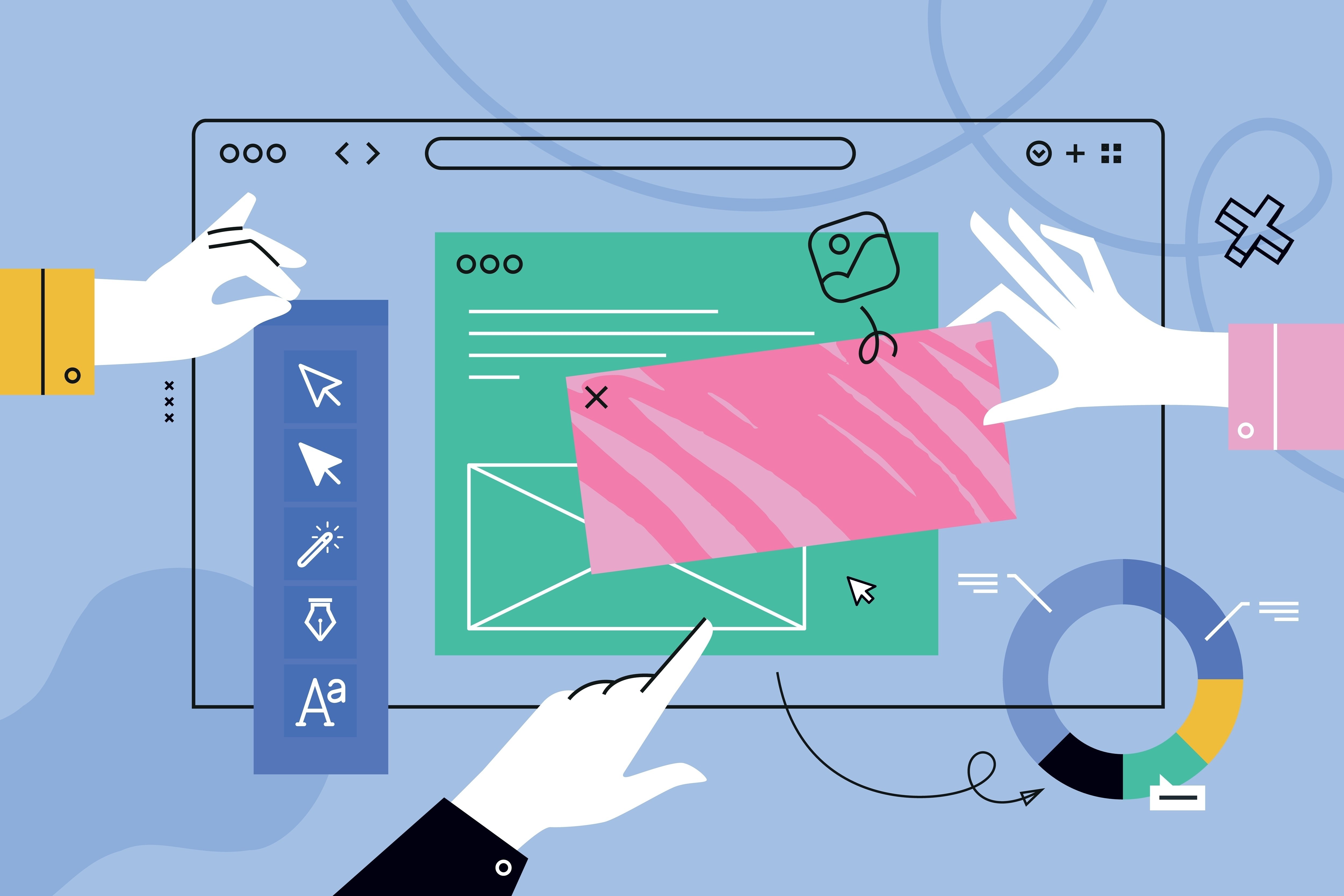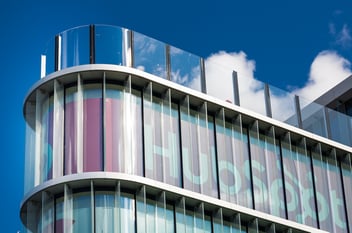How Long Does it Take to Redesign a Website? Here’s a Realistic Timeline

A website is one of the first impressions potential customers have of your business. An outdated or poorly designed website can deter visitors from trusting and interacting with your brand, hindering your credibility. On the other hand, a well-designed website with a good user experience can help build trust and set the relationship off on the right foot, making a positive impact and encouraging potential customers to engage with your brand.
Take a moment to assess your current website. Does it provide the user experience you want? Does it align with your current branding and performance goals?
Try our website grader tool to see where your site stands and discover how a redesign can make a significant difference.
So, could your website use a makeover? If so, you may have some questions before you start this project. How long does it take to redesign a website? What elements should a website redesign include? Can we tackle this project in-house?
We’re here to give you the inside scoop on all this and more. Let’s dive in!
How Long Does It Take to Redesign a Website?
A website development timeline can vary greatly depending on several factors. Here’s a breakdown of the key elements that influence a redesign timeline:
Factors Influencing the Timeline:
- Website Size and Complexity: The larger and more complex your website, the longer the redesign process will take. A simple site with a few pages will take less time than a large e-commerce site with numerous products and integrations.
- Resources and Team Expertise: Your team's availability and skill level can significantly impact the timeline. An experienced team with specialized skills can work more efficiently and effectively, reducing the required time.
- Specific Project Requirements: Custom features, integrations, and unique design elements can prolong the project timeline. Defining your requirements at the beginning can help manage expectations and streamline the process.
- Rebranding Needs: One of the largest factors influencing timelines is whether you want a rebrand in addition to the website redesign. If a rebrand is desired, especially with specific designs that require a custom theme versus a HubSpot marketplace theme, the timeline can be extended to accommodate these additional elements.
Average Website Development Timeline:
- Small Website: 2-3 months. This includes simple websites with a limited number of pages, basic functionality, and a standard site design that can follow a theme.
- Medium Website: 3-6 months. This covers websites with more pages, custom features, and potentially more complex integrations.
- Large Website: 6+ months. Due to their complexity, large websites, such as e-commerce sites or those with extensive content and functionality, require a longer timeline.
Here’s an Example of a Standard Website Development Timeline
Redoing your website is a big deal and rushing it isn't the way to go. Set yourself up for success with a realistic timeline for development. Here's a peek at what a standard web project timeline looks like:
Phase 1: Planning (2-4 weeks)
- Discovery and Goal Setting: Identify the redesign's objectives, your business’s target audience, and key performance indicators (KPIs).
- Research and Analysis: Conduct market research, analyze competitors, and gather user feedback for design and functionality decisions.
- Audit Current Site: Evaluate the existing website design, user experience (UX), and SEO to understand its strengths and weaknesses. This provides a solid foundation for redesign efforts.
Phase 2: Design (4-8 weeks)
- Moodboards and Design Concepts: Develop mood boards and initial design concepts to explore and finalize the design direction with the client.
- Wireframing and Prototyping: Create wireframes to outline the site’s structure and user flow. Develop prototypes to visualize the design and functionality.
- Design Approval: Present the design to stakeholders for feedback and make necessary revisions until approval is obtained.
Phase 3: Development (6-12 weeks)
- Front-End and Back-End Development: Build the website's front-end (what users see) and back-end (server-side) components.
- Integrations and Functionality: Implement necessary integrations, such as CRM systems, e-commerce platforms, or third-party tools. Ensure all features and functionalities are working correctly.
Phase 4: Testing and Launch (2-4 weeks)
- Quality Assurance and Testing: Perform comprehensive testing to identify and fix any bugs or issues. This includes usability testing, performance testing, and cross-browser compatibility checks.
- Mapping Out Redirects: Ensure SEO continuity by mapping out redirects from the old site to the new one to prevent 404 errors and maintain search engine rankings.
- Final Adjustments and Launch: Make any final adjustments based on testing feedback. Prepare for the website launch, including setting up hosting, domain, and any necessary security measures.
Note on Timelines: These timelines are estimates and can vary based on your project's specific needs and complexity. Factors such as additional revisions, unexpected challenges, and the efficiency of the communication process can influence the overall timeline. Working with an experienced agency can help keep your project on track and ensure a smooth and timely redesign process.
5 Signs You Could Benefit From a Website Redesign
Think your website might need a facelift but want a second opinion? No worries. Take a look below. If your site shows any of these signs, a redesign could be a game-changer.
1. Outdated Design and Technology:
Has your website been stuck in a time warp or built on ancient tech? It might be crying out for a makeover. Fresh design trends and new tech can seriously up your site's game in looks, feel, and functionality.
2. Poor User Experience and Navigation:
Visitors should find what they need without a hitch. If your site's navigation feels like a maze or the user experience is a headache, you’re probably losing leads and customers left and right.
3. Declining Website Performance and Metrics:
Seeing a drop in traffic, engagement, or conversions? Slow load times, broken links, and other issues can send visitors running for the hills.
4. Rebranding or New Business Goals:
As your business evolves, your website should keep pace. If you’ve rebranded, launched new products, or aimed at a different market, a redesign ensures your site says, "Hey, we’re up to date!"
5. Mobile Responsiveness Issues:
With most folks browsing on their phones, having a mobile-friendly site is a must. If your site’s a pain on smartphones and tablets, it’s definitely time for a redesign.
What’s the Best Way to Execute a Website Redesign?
When redesigning your website, choosing the right approach is crucial. An agency might be the best choice for a complex, time-sensitive project, while a freelancer could be ideal for smaller, budget-conscious tasks. Evaluate your specific needs, budget, and goals to make the best decision for your business. Here are the main options to consider:
Hiring an Agency
Pros:
- Expertise: Agencies have teams of specialists with extensive experience in website design and development.
- Speed: With a dedicated team, agencies can often complete projects more quickly.
- Comprehensive Services: Agencies offer everything under one roof—design, development, SEO, and even support when things go sideways.
Cons:
- Cost: Hiring an agency can be a larger investment, which might not be feasible for all businesses.
Working with a Freelancer
Pros:
- Cost-effective: Freelancers generally charge less than agencies.
- Flexible: Freelancers can often be more flexible in their approach and schedule.
Cons:
- Limited Resources and Expertise: One freelancer might not have all the tricks and tools up their sleeve that an agency does, which can cap the project's potential.
In-House Team
Pros:
- Total Control: You have complete oversight of the project, allowing you to manage every detail and make real-time adjustments as needed.
- Aligned with Company Vision: In-house teams are usually more familiar with the company’s goals, culture, and brand.
Cons:
- Time-consuming: Doing everything in-house can drag on since your team might be juggling multiple tasks.
- May Lack Specialized Skills: Your crew could be missing some key skills needed for a full-scale redesign.
Key Elements to Include in Your Website Redesign:
If you think now is the time for a website redesign, here are some key elements to focus on to make sure your new site crushes your business goals and enhances user experience:
New Sitemap
- A well-organized sitemap helps visitors find information quickly and improves navigation. It also assists search engines in indexing your site more effectively.
- Use a tool like Google's Sitemap Generator. Start by listing all the pages on your current site, then organize them into categories that make sense for your users. Ensure each page has a clear purpose and logically fits your site's structure.
New Branding
- Your website should match your brand’s latest vibe. Think logo, color scheme, fonts, and that overall visual flair.
- Make sure everything on your site looks like it belongs together. Your messaging needs to clearly showcase your brand’s values, mission, and what makes you special. Consistency is key—it builds trust and gets your audience to recognize you in a heartbeat.
Usability Features
- Prioritize a clean, intuitive design that effortlessly guides users through your site. This includes easy-to-use navigation menus, clear calls to action, and well-organized content.
- Make your site accessible to all users, including those with disabilities. Use accessible design principles, such as appropriate color contrasts, text size adjustments, and screen reader compatibility. To test and improve website accessibility, you can utilize various helpful tools recommended by HubSpot.
Content and SEO Strategy
- High-quality, relevant content engages visitors and improves your search engine rankings. Develop a content strategy that includes regular updates and addresses the needs and interests of your target audience.
- Review and update your existing content to align with your new branding and messaging. Optimize your content for SEO by incorporating relevant keywords, improving meta tags, and ensuring fast load times.
What Are the Benefits of Using Hubspot for a Website Redesign?
When it comes to streamlining the website redesign process, HubSpot offers a range of benefits that can make everything go smoother:
- Integrated CMS and Marketing Tools: HubSpot’s Content Management System (CMS) is fully integrated with its suite of marketing tools. You can manage your website content, marketing campaigns, and customer interactions in one place.
- SEO Optimization Features: HubSpot provides built-in SEO tools that help you optimize your website content for search engines. From keyword suggestions to on-page SEO recommendations, these tools ensure your site is search engine-friendly, helping you improve your rankings and drive more organic traffic.
- User-Friendly and Customizable Templates: HubSpot offers a wide variety of user-friendly and customizable templates. These templates are designed to be responsive and can be easily tailored to fit your brand’s unique look and feel.
- Analytics and Reporting: HubSpot’s robust analytics and reporting tools allow you to track your website’s performance in real time. You can monitor key metrics such as traffic, engagement, and conversion rates.
- Personalization Features: With HubSpot, you can personalize the user experience based on visitor behavior and demographics. This can lead to higher engagement and conversion rates, as your website can dynamically adjust content and calls-to-action to meet individual users' needs better.
- Scalability: Whether you’re a small startup or a large enterprise, HubSpot’s scalable solutions ensure that your website can handle increasing traffic and more complex marketing requirements over time.
- Support and Resources: HubSpot offers extensive support and resources, including a comprehensive knowledge base, customer support, and a community of users.
Get Connected With HubSpot Experts
Is It Time for a Website Redesign? Evenbound Has You Covered!
If your website looks outdated, performs poorly, or doesn't align with your brand anymore, it might be time for a redesign. At Evenbound, we’ve got your back! We craft high-performing websites that fit your unique needs like a glove.
Our expert team handles everything—from strategic planning and cutting-edge design to
seamless development and ongoing support. We’re your all-in-one web gurus!
Contact us at Evenbound today and see how we can level up your online presence!



